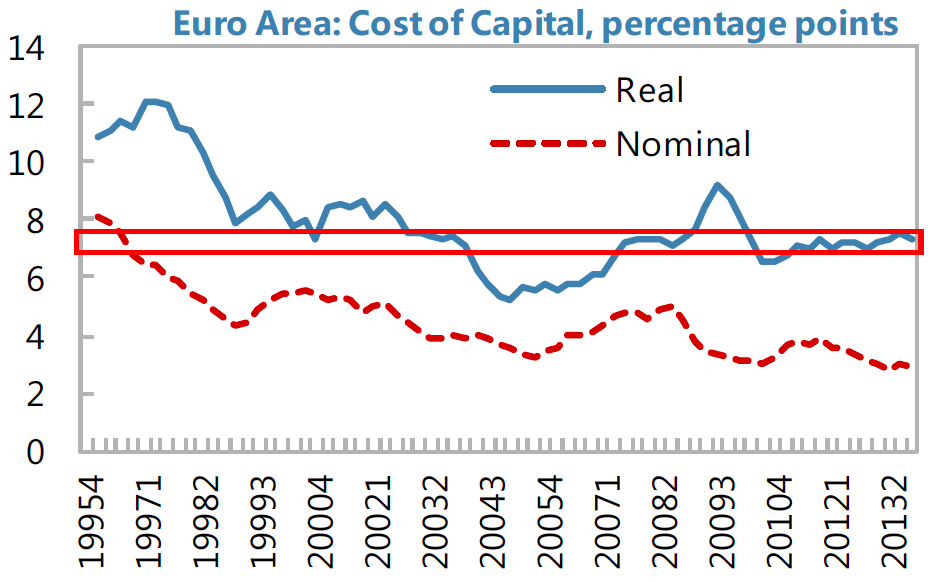23/8/2014: Real Cost of Capital: Euro 'Periphery' Dilemma
Staying on the topic of debt (see earlier post: http://trueeconomics.blogspot.ie/2014/08/2382014-that-pesky-problem-of-real-debt.html) here is IMF research on real cost of corporate capital (linked to the cost of debt) in the Euro area 'periphery' (this is from an IMF July 2014 publication that accompanied its Article 4 paper on Euro Area).
I highlighted with the red the range of recent capital costs range in each country to trace out historical comparatives.
Starting with the Euro area as a whole:
Two points:
- Current real cost of capital across the euro area is relatively benign, compared to both 1990s - early 2000s period and shows low volatility in recent (crisis) years post 2009 peak
- 2009 peak is pronounced but moderate compared to the one found in some 'peripheral' countries.
In basic terms, this means that euro area's capital costs are benign - above the 2004-2007 trough, but historically well below those observed in the 1990s.
Spain:
Two points:
- Current capital cost levels are consistent with crisis peak
- Capital today is as expensive in real terms as in the pre-euro era.
Which means that Spanish real cost of capital is now as bad as in the pre-euro period and is much worse than during the credit boom of the late 1990s-early 2000s.
Italy:
Two points:
- Just as in Spain, real capital costs in Italy are comparable with peak of the crisis and
- Capital costs today are more expensive than in the 2000s, but less expensive than in pre-euro era.
Italy's overall real cost of capital is currently comparable to the one observed in the late 1990s, and is higher than the one experienced in the credit expansion period of the early 2000s. That said, the cost uplift on 2000s is relatively moderate.
Portugal:
Two points:
- Capital costs today is below the peak levels of the crisis in real terms, but is severely elevated relative to 2000s and on-par with pre-euro era costs;
- Capital cost volatility is high and it was high during the entire euro era.
Thus, Portugal's real cost of capital is highly volatile, but on average is higher today than in the entire period from 1997 through 2010.
Ireland:
Ireland is clearly 'unique' compared to both the Euro area and the rest of the 'periphery' when it comes to the real cost of capital.
- The crisis peak in real cost of capital is massively out of line with historical trends.
- Ignoring the crisis peak, current real cost of capital is running well above the pre-crisis historical levels;
- Since the introduction of the euro, real cost of capital in Ireland trended above the pre-euro period levels
In summary, real cost of capital across the euro area 'periphery' shows one simple thing: investment is still a very costly proposition for businesses, especially compared to the pre-crisis period. Worse, it is now as expensive than (or comparable to) the cost averages for the pre-euro area period.
The above puts stark contrast between the cost of funding the banks (low) and Governments (historically low today) and real businesses (high).







Comments
Post a Comment